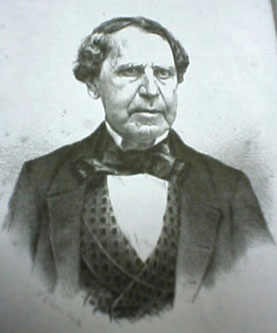Slide 15

Henry B. Curtis
To select a new site in Knox County for Kenyon College, Bp. Chase obtained the help of a young Mount Vernon lawyer named Henry B. Curtis. Years later, in 1859, Curtis would retell the story of the selection of the site in the Kenyon Collegian.
It was on a bright summer morning (July 22, 1825), that a party of gentlemen started from Mount Vernon with Bishop Chase, for the purpose of exploring the country eastward of and adjacent to this city, with a view to the selection of a suitable site for the Theological Seminary and Kenyon College. We were all on horseback.
It was well known that Mr. William Hogg, of Brownsville, Pennsylvania, owned a tract of 8,000 acres of land-- two military sections of 4,000 acres each-- lying a few miles east of here, which, from the varied character of its surface, and the beauties of its streams and valleys, it was suggested might offer a suitable location for the proposed Seminary and College.
We went out on what is called the Coshocton Road, and struck the land of Mr. Hogg, on the west boundary of what has since been called the "North Section," at a distance of about four miles. We proceeded through the section, noticing many pleasant features. Thence down the valley of "Schenk's Creek," to the junction of that stream with "Owl Creek," and thence turning again westward, and proceeding up that river, and generally near its margin, we again entered the lands of William Hogg, at the eastern boundary of the "South Section."
On this section there were several cabins, and a number of small farms opened. The road lay across the beautiful valley, and again striking the rive; followed its margin in a pretty straight line, until interrupted by the abrupt descent of what is now the "College Hill."
I had once, on a previous occasion, crossed over this hill, or promentory, and it was with reference to this spot that I desired the party to return by this route. Arriving, therefore, at the base of "the hill," on its south side, I called the attention of the Bishop and others of the party, to the elevation on the right, and its beautiful surroundings. But it was suggested by Mr. Norton that there was not room enough on the crown of the hill for the accommodation of the necessary buildings and grounds for the contemplated Institution. To this I replied that I had once crossed the hill, and that there was a level plain on top, of wider extent than was supposed.

